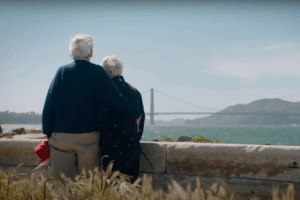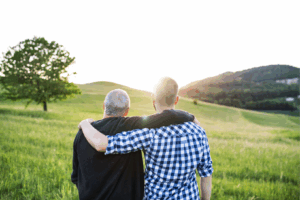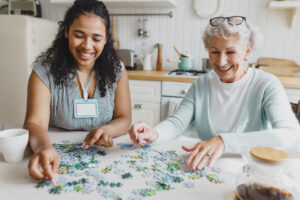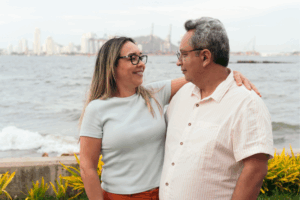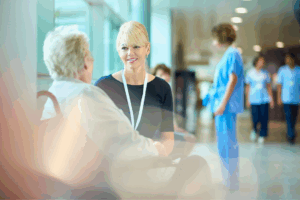On January 4th, 2018, at 2:39 in the morning, the Hayward fault line began to rumble. For 5-10 seconds, a region nearly 150 miles across shook, from Silicon Valley to Marin and Sonoma, and across San Francisco. While this was only a Magnitude 4.4 on the Richter Scale (M4.4), it woke people up and left them unnerved.
Earthquakes are nothing unusual in the Bay Area. In fact, they are a part of daily life. But because they are so normal, it can be easy to become complacent. Even if we know that it is vital to be prepared for earthquakes, it’s common for our preparedness to slip as memories of large, damaging tremblers recede. That isn’t acceptable for anyone, and it is especially dangerous for older adults in the Bay Area.
It’s easy to forget to plan stuff. It’s easy to forget during times of transition, whether those are literal ones like moving to a smaller house or just the transition of aging. It’s also easy to forget after time has passed and you’ve gotten into a comfortable daily routine that seems far removed from danger. But no matter where you are, you have to have an updated and ready plan for when disaster strikes.
We don’t know when earthquakes will hit. But we can be prepared for when they do.
It’s Everybody’s Fault
If you have lived in the Bay Area for a while, you probably remember the Loma Prieta earthquake of 1989 (aka, the World Series quake). That 6.9 killed 63 people, injured thousands more, and caused highways to pancake and the Bay Bridge to partially collapse.
But even that quake, on the San Andreas fault, was nearly 30 years ago, and the devastating 1906 quake is sepia-toned history. The last big Hayward rupture happened even longer ago, in 1868, and the Hayward fault has since been built over, meaning a major quake would create exponentially greater damage today. As Earth Magazine puts it:
[I]immediately after a magnitude-7 Hayward Fault event, out of 920,502 households near the fault trace, 298,605 (32 percent) will be without water and 367,519 (40 percent) will be without electricity. These losses are just the beginning of the infrastructure problems a Hayward Fault quake will create. A big quake in a highly populated area means that virtually every aspect of modern civilization—transportation, gas, sewer, water, electricity, Internet access and more — will be affected.
Read the whole article if you want to see the full scope. But we’re not trying to scare you. We’re trying to make you aware that these faults will go off at some point in the future. Maybe not in your lifetime; maybe soon. We don’t know. We just know that in the Bay Area, earthquake preparedness for older adults is crucial.
Being Prepared
There are many reasons older adults may need extra help and preparedness during a disaster. These reasons include:
- Physical ailments
- Diminished sensory awareness
- Dementia or Alzheimer’s
- Limited mobility
- Chronic pain/illness
- Social and economic limitations
No matter who you are, earthquakes can be disorienting, but if you have any mental or physical impairments, they are particularly so. That’s why you need to plan in advance.
There are many things you can do to prepare yourself for an earthquake, starting with before one hits.
Before the Quake
- Make sure fragile or valuable items are secured. You don’t want expensive or even priceless items crashing. You especially don’t want the floor to be covered in glass or other obstacles if you, like many older adults, have a hard time getting around. Securing items means easier and safer movement after a quake.
- Store the supplies you need. Every home in the Bay Area should have a kit with water, water purification tablets, maps, non-perishable food, and more. Ready.gov has a full list, but older adults should also have extra medication in their kits. If there is a true disaster, you don’t want to leave without it in the confusion and fear.
- Create an emergency plan with family members. Have ways to communicate when communication is down, no matter where you are in the area. If you need help walking or moving, make sure that is part of the plan, even if you are in the same house. Have a designated wheelchair pusher, or someone prepared to carry your bag. Having these decisions made in advance can save precious time.
- Know community services before the quake. The American Red Cross offers civilian disaster preparedness training and will also be there after disaster strikes. But know where you can find shelters and hospitals, and the best routes to get there.
When the Quake Hits
- Drop. Take Cover. Hold On. If you can get to the ground, do so. Get under something sturdy. If you are in bed, stay in bed and cover your head and neck with your pillow.
- Follow the plan as much as possible. When you move slower, altering plans and improvising can be doubly slow. To the extent that it is possible, follow your pre-approved plan.
- Monitor local broadcasts for emergency and relief information. A battery-powered shortwave radio can be your best friend. Follow their instructions.
A Few More Tips
- Watch out for scams. In the wake of disaster, we see the best in people. We see communities coming together, and rallying to help out the most vulnerable. Unfortunately, we also often see the worst. There are people who try to take advantage of the wounded and scared and vulnerable. Talk to people you trust, and rely on the official aid services, not strangers who offer help for a cost.
- You can’t take it with you. Many older adults tend to not want to leave their homes, especially if they are aging in place and in long-time homes. It’s ok to be comfortable in your surroundings but dangerous to be attached to that over your life. During Hurricane Katrina, 70% of the casualties were older adults. Part of that was due to the inhumane conditions and shattered support systems that made the most vulnerable even more so, but it was also due to people refusing to evacuate. Follow instructions and leave dangerous areas.
- Research. If this is the first article you read about earthquake preparedness for older adults, don’t let it be your last. It’s a guide toward other guides. We recommend:
- Disaster Planning Tips for Older Adults and Their Families (CDC)
- Disaster Preparedness: For Seniors by Seniors (Red Cross)
- Bay Area Earthquake Resource Guides (San Francisco Chronicle)
- Earthquakes (Ready.gov)
So don’t think every clattering rumble of a garbage truck in the alley is the end of the world. We don’t want you to live a life in fear, jumping at shadows. We don’t want that in any situation, earthquakes or not. We want you to live your life to the fullest, every day.
But in the Bay Area, that means being ready for earthquakes. When you are prepared, little tremors aren’t a source of panic because you have a plan and know how to react. No one knows exactly what the next big one will bring, but with a solid plan in place, you have put yourself in a great position to stay safe and in control.
We think that’s an ideal to carry with you in every part of your life.
At Institute on Aging, our programs and services help older adults, their families, and caregivers explore aging together, through good times and bad, as an adventure and a journey. Connect with us today to learn more.

